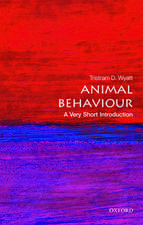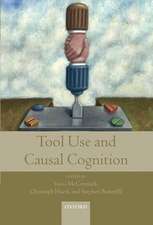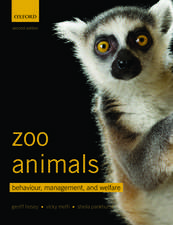Predator-Prey Dynamics: The Role of Olfaction
Autor Michael R. Conoveren Limba Engleză Paperback – 23 sep 2019
Predator-Prey Dynamics: The Role of Olfaction examines environmental as well as biological and behavioral elements of both predators and prey to answer gaps in our current knowledge of the survival dynamics of species. Beginning with a thorough look at the mechanics of olfaction, the author explains how predators detect, locate, and track their prey using odor trails on the ground or odor plumes in the air. Understanding the physics of airflow is the next step to understanding the potential for manipulating and masking scent. While a bush may conceal an animal visually from a predator, it will not protect an animal from a predator using olfaction. To hide from the latter, an animal needs to hide in locations where turbulence and updrafts will disperse its scent.
The book addresses tradeoffs that animals must make given their dual needs to hide from predators and to procure food and water. Studies of mammalian and avian behavior provide examples on the actual use and efficacy of olfactory camouflage tactics. The book concludes with a redefinition of ecological terms based on the physics of airflow and a summary of the theory and implications of olfactory predator--prey dynamics.
Introducing the mechanics of olfaction and its influence on the behavior of both predators and prey, Predator-Prey Dynamics: The Role of Olfaction presents a new perception of the world and enables us to understand and more effectively manage the delicate survival dynamics of animals in the wild.
| Toate formatele și edițiile | Preț | Express |
|---|---|---|
| Paperback (1) | 489.26 lei 6-8 săpt. | |
| CRC Press – 23 sep 2019 | 489.26 lei 6-8 săpt. | |
| Hardback (1) | 1278.88 lei 6-8 săpt. | |
| CRC Press – 30 mar 2007 | 1278.88 lei 6-8 săpt. |
Preț: 489.26 lei
Preț vechi: 575.60 lei
-15% Nou
Puncte Express: 734
Preț estimativ în valută:
93.62€ • 97.95$ • 77.77£
93.62€ • 97.95$ • 77.77£
Carte tipărită la comandă
Livrare economică 02-16 aprilie
Preluare comenzi: 021 569.72.76
Specificații
ISBN-13: 9780367389291
ISBN-10: 0367389290
Pagini: 264
Dimensiuni: 178 x 254 x 15 mm
Greutate: 0.45 kg
Ediția:1
Editura: CRC Press
Colecția CRC Press
ISBN-10: 0367389290
Pagini: 264
Dimensiuni: 178 x 254 x 15 mm
Greutate: 0.45 kg
Ediția:1
Editura: CRC Press
Colecția CRC Press
Public țintă
Academic and Professional ReferenceCuprins
Olfactory Predators and Odorants, Detecting and Locating Prey Through Depositional Odor Trails, Using Airborne Odorants to Detect the Presence of Prey, Using Odor Plumes to Locate Prey and the Impact of Convection, Experimental Evidence that Updrafts and Turbulence Hinder the Ability of Predators to Find Prey Using Olfaction, Turbulence Caused by Isolated Surface Features, Turbulence Over Rough Surfaces, Turbulence Within and Below Plant Canopies, Trade-Offs Required to Achieve Optimal Hiding Strategies, Impact of Olfactory Predators on the Behavior of Female Ungulates During Parturition and on the Behavior of Their Young, Do Nest Site Characteristics Influence Nest Predation Rates by Olfactory Predators? Do Weather, Convection, Isolated Surface Features, or Shelterbelts Influence Nest Predation Rates of Olfactory Predators? Do Prairies, Savannas, Forests, or Edge Habitats Influence Nest Predation Rates of Olfactory Predators? Using the Physics of Airflow to Redefine Common Ecological Terms, Epilogue, References, Appendices, Index
Descriere
By presenting an abundance of scientific evidence throughout the text on olfaction and the olfactory concealment theory, Predator-Prey Dynamics reshapes the way that scientists view animal behavior. The olfactory concealment theory demonstrates that olfaction is an effective method used by predators to locate prey because animals constantly release a stream of odorants. However, animals can minimize their risk of being detected by an olfactory predator by hiding where updrafts, turbulence and suboptimal wind speeds occur (all predictable in time and space). Using published literature to test predictions, this book will help biologists and wildlife professionals manage olfactory predators and their prey.












